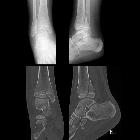Tillaux fracture









 nicht verwechseln mit: Tubercule de Tillaux Chaput
nicht verwechseln mit: Tubercule de Tillaux ChaputTillaux fractures are Salter-Harris III fractures through the anterolateral aspect of the distal tibial epiphysis, with variable amounts of displacement.
Epidemiology
It occurs in older children and adolescents when the medial aspect of the distal tibial growth plate has started to fuse.
Pathology
The fracture commonly results from an abduction-external rotation mechanism. With this mechanism, the anterior tibiofibular ligament avulses the anterolateral corner of the distal tibial epiphysis .
The fracture requires an open physis (the lateral aspect of the distal tibial physis usually closes between 12 to 15 years of age while the medial aspect closes earlier). The lateral epiphyseal involvement is due to growth plate fusion commencing from medial to lateral aspect.
Radiographic features
Vertical fracture through the distal tibial epiphysis (SH III) with a horizontal extension through the lateral aspect of the physis. The lack of a metaphyseal fracture component in the coronal plane (evaluated with lateral x-ray or CT) distinguishes a Tillaux fracture from a triplanar fracture.
Treatment and prognosis
The degree of displacement will dictate management. Operative reduction and internal fixation (ORIF) is required when the displacement is marked or unable to be eliminated with closed reduction.
Complications
As with any intra-articular fracture if a step is left in the articular surface, then the joint will go on to premature secondary osteoarthritis.
History and etymology
It is named after Paul Jules Tillaux, French surgeon and anatomist (1834-1904) .
Siehe auch:
- Tubercule de Tillaux Chaput
- Salter-Harris Klassifikation
- Salter-Harris Typ 3 Fraktur
- distale Tibiafraktur
- Wagstaffe-Le Fort-Fraktur (Fibula)
- Triplane-Fraktur
und weiter:

 Assoziationen und Differentialdiagnosen zu Tillauxfraktur:
Assoziationen und Differentialdiagnosen zu Tillauxfraktur:




